8.4: Ming Dynasty (1368-1644 CE)
- Page ID
- 224451
\( \newcommand{\vecs}[1]{\overset { \scriptstyle \rightharpoonup} {\mathbf{#1}} } \)
\( \newcommand{\vecd}[1]{\overset{-\!-\!\rightharpoonup}{\vphantom{a}\smash {#1}}} \)
\( \newcommand{\id}{\mathrm{id}}\) \( \newcommand{\Span}{\mathrm{span}}\)
( \newcommand{\kernel}{\mathrm{null}\,}\) \( \newcommand{\range}{\mathrm{range}\,}\)
\( \newcommand{\RealPart}{\mathrm{Re}}\) \( \newcommand{\ImaginaryPart}{\mathrm{Im}}\)
\( \newcommand{\Argument}{\mathrm{Arg}}\) \( \newcommand{\norm}[1]{\| #1 \|}\)
\( \newcommand{\inner}[2]{\langle #1, #2 \rangle}\)
\( \newcommand{\Span}{\mathrm{span}}\)
\( \newcommand{\id}{\mathrm{id}}\)
\( \newcommand{\Span}{\mathrm{span}}\)
\( \newcommand{\kernel}{\mathrm{null}\,}\)
\( \newcommand{\range}{\mathrm{range}\,}\)
\( \newcommand{\RealPart}{\mathrm{Re}}\)
\( \newcommand{\ImaginaryPart}{\mathrm{Im}}\)
\( \newcommand{\Argument}{\mathrm{Arg}}\)
\( \newcommand{\norm}[1]{\| #1 \|}\)
\( \newcommand{\inner}[2]{\langle #1, #2 \rangle}\)
\( \newcommand{\Span}{\mathrm{span}}\) \( \newcommand{\AA}{\unicode[.8,0]{x212B}}\)
\( \newcommand{\vectorA}[1]{\vec{#1}} % arrow\)
\( \newcommand{\vectorAt}[1]{\vec{\text{#1}}} % arrow\)
\( \newcommand{\vectorB}[1]{\overset { \scriptstyle \rightharpoonup} {\mathbf{#1}} } \)
\( \newcommand{\vectorC}[1]{\textbf{#1}} \)
\( \newcommand{\vectorD}[1]{\overrightarrow{#1}} \)
\( \newcommand{\vectorDt}[1]{\overrightarrow{\text{#1}}} \)
\( \newcommand{\vectE}[1]{\overset{-\!-\!\rightharpoonup}{\vphantom{a}\smash{\mathbf {#1}}}} \)
\( \newcommand{\vecs}[1]{\overset { \scriptstyle \rightharpoonup} {\mathbf{#1}} } \)
\( \newcommand{\vecd}[1]{\overset{-\!-\!\rightharpoonup}{\vphantom{a}\smash {#1}}} \)
\(\newcommand{\avec}{\mathbf a}\) \(\newcommand{\bvec}{\mathbf b}\) \(\newcommand{\cvec}{\mathbf c}\) \(\newcommand{\dvec}{\mathbf d}\) \(\newcommand{\dtil}{\widetilde{\mathbf d}}\) \(\newcommand{\evec}{\mathbf e}\) \(\newcommand{\fvec}{\mathbf f}\) \(\newcommand{\nvec}{\mathbf n}\) \(\newcommand{\pvec}{\mathbf p}\) \(\newcommand{\qvec}{\mathbf q}\) \(\newcommand{\svec}{\mathbf s}\) \(\newcommand{\tvec}{\mathbf t}\) \(\newcommand{\uvec}{\mathbf u}\) \(\newcommand{\vvec}{\mathbf v}\) \(\newcommand{\wvec}{\mathbf w}\) \(\newcommand{\xvec}{\mathbf x}\) \(\newcommand{\yvec}{\mathbf y}\) \(\newcommand{\zvec}{\mathbf z}\) \(\newcommand{\rvec}{\mathbf r}\) \(\newcommand{\mvec}{\mathbf m}\) \(\newcommand{\zerovec}{\mathbf 0}\) \(\newcommand{\onevec}{\mathbf 1}\) \(\newcommand{\real}{\mathbb R}\) \(\newcommand{\twovec}[2]{\left[\begin{array}{r}#1 \\ #2 \end{array}\right]}\) \(\newcommand{\ctwovec}[2]{\left[\begin{array}{c}#1 \\ #2 \end{array}\right]}\) \(\newcommand{\threevec}[3]{\left[\begin{array}{r}#1 \\ #2 \\ #3 \end{array}\right]}\) \(\newcommand{\cthreevec}[3]{\left[\begin{array}{c}#1 \\ #2 \\ #3 \end{array}\right]}\) \(\newcommand{\fourvec}[4]{\left[\begin{array}{r}#1 \\ #2 \\ #3 \\ #4 \end{array}\right]}\) \(\newcommand{\cfourvec}[4]{\left[\begin{array}{c}#1 \\ #2 \\ #3 \\ #4 \end{array}\right]}\) \(\newcommand{\fivevec}[5]{\left[\begin{array}{r}#1 \\ #2 \\ #3 \\ #4 \\ #5 \\ \end{array}\right]}\) \(\newcommand{\cfivevec}[5]{\left[\begin{array}{c}#1 \\ #2 \\ #3 \\ #4 \\ #5 \\ \end{array}\right]}\) \(\newcommand{\mattwo}[4]{\left[\begin{array}{rr}#1 \amp #2 \\ #3 \amp #4 \\ \end{array}\right]}\) \(\newcommand{\laspan}[1]{\text{Span}\{#1\}}\) \(\newcommand{\bcal}{\cal B}\) \(\newcommand{\ccal}{\cal C}\) \(\newcommand{\scal}{\cal S}\) \(\newcommand{\wcal}{\cal W}\) \(\newcommand{\ecal}{\cal E}\) \(\newcommand{\coords}[2]{\left\{#1\right\}_{#2}}\) \(\newcommand{\gray}[1]{\color{gray}{#1}}\) \(\newcommand{\lgray}[1]{\color{lightgray}{#1}}\) \(\newcommand{\rank}{\operatorname{rank}}\) \(\newcommand{\row}{\text{Row}}\) \(\newcommand{\col}{\text{Col}}\) \(\renewcommand{\row}{\text{Row}}\) \(\newcommand{\nul}{\text{Nul}}\) \(\newcommand{\var}{\text{Var}}\) \(\newcommand{\corr}{\text{corr}}\) \(\newcommand{\len}[1]{\left|#1\right|}\) \(\newcommand{\bbar}{\overline{\bvec}}\) \(\newcommand{\bhat}{\widehat{\bvec}}\) \(\newcommand{\bperp}{\bvec^\perp}\) \(\newcommand{\xhat}{\widehat{\xvec}}\) \(\newcommand{\vhat}{\widehat{\vvec}}\) \(\newcommand{\uhat}{\widehat{\uvec}}\) \(\newcommand{\what}{\widehat{\wvec}}\) \(\newcommand{\Sighat}{\widehat{\Sigma}}\) \(\newcommand{\lt}{<}\) \(\newcommand{\gt}{>}\) \(\newcommand{\amp}{&}\) \(\definecolor{fillinmathshade}{gray}{0.9}\)Introduction
In the Ming Dynasty, China experienced remarkable growth with the population doubling and extensive trade with the rest of the world. Emperor Hongwu (8.4.1), formerly known as Zhu Yuanzhang, lived as a beggar in a Buddhist monastery before he joined one of the military organizations. He quickly ascended through the ranks and led the forces to drive the Mongols out of China, establishing the Ming dynasty. Despite using strict methods, Emperor Hongwu reformed the government, purged the military of corrupt high-ranking generals, seized large estates, and prohibited Mongol customs, even changing the people's clothing from the Mongol style to a different fashion. One of Zhu Yuanzhang's greatest accomplishments was the establishment of the Yellow Register Archives, a monumental population survey. It was the largest survey in the world before modern times, originally intended for tax purposes, but went beyond taxation and became a long-lasting record of the Chinese people.

In the 15th century, during the Ming dynasty, the population was 85 million. Professor Craig Clunas from Oxford wrote: "It had a greater land area, bigger cities (and more big cities), bigger armies, bigger ships, bigger palaces, bigger bells, more literate people, more religious professionals."[1]
Maintaining peace and stability during the reign of Zhu presented numerous challenges. The Mongols engaged in constant fighting along the borders, enforcing newly introduced regulations proved difficult, and providing employment and food to a large population of peasants was no easy feat. In order to solidify his reign and prevent any rebellions from regional leaders or ministers, Zhu relied on his family and sons. Drawing on Confucian ideals and values, he established rules for his family and granted his sons some autonomy within their local domains. The Prince of Yan, one of Zhu's sons, resided in Beijing and extended his authority and influence by building a robust network of contacts and support. Nevertheless, Zhu remained vigilant against potential uprisings and worked tirelessly to maintain peace and order throughout his rule.
Following the passing of Emperor Hongwu, his recorded line of succession began to unravel, resulting in a series of court machinations and conflicts between potential heirs. The Prince of Yan used deceit and defamation to strengthen his claim to the throne, ultimately sparking a brutal civil war that claimed countless lives. Despite the prolonged struggle, the Prince of Yan eventually emerged victorious, capturing the Nanjing capital and proclaiming himself Emperor Yongle, a name symbolizing Everlasting Happiness. He subsequently relocated the capital to Beijing. As emperor, he needed to ensure the strength of his position and "undertook two enormous projects…the compilation of an authoritative 11,095 volume encyclopedia of Chinese learning and the construction of the Imperial Palace in Beijing over the ruins of Khubilai Kahn's capital."[2]
The Exhibition explores the years 1400 – 1450, a pivotal 50 year period that transformed China during the rule of the Ming dynasty. The exhibition features a range of these spectacular objects – including exquisite porcelain, gold, jewellery, furniture, paintings, sculptures and textiles. Many of the objects have only very recently been discovered and have never before been seen outside China.
Forbidden City
In ancient times, people believed that the star of Ziwei, also known as Polaris, always remained stationary. They believed that the star was surrounded by a bright purple constellation and that it was the abode of the Great Imperial Ruler of Heaven. In China, the emperor was considered to be the son of the Great Imperial Ruler of Heaven, and his palace was named the Purple Forbidden City.[3] Starting with the Ming Dynasty, the Forbidden City (8.4.2) in Beijing was constructed between 1406 and 1420 CE by over one hundred thousand craftsmen and over a million laborers. It was the home of the emperors and the governmental center for almost 500 years. The city was extensive and contained over 950 buildings, a style now considered traditional architecture for Chinese buildings. The complex was made of wood and designed around a central axis (also called the Imperial Path) and symmetrical design; the front, outer, and rear inner courts.
…more than a million precious royal collections, articles used by the royal family and a large number of archival materials on ancient engineering techniques, including written records, drawings and models, are evidence of the court culture and law and regulations of the Ming and Qing dynasties.[4]

On the Plan of the Forbidden City (8.4.3), the Meridian Gate (A) is the main entrance to the city from the outside, the Gate of Divine Might (B) the back entrance, with (C) and (D) as side entrances and guard towers located in each corner (E). The Gate of Supreme Harmony (F) forms the gateway to the inner court in the inner courtyard. The Hall of Supreme Harmony (G) is located in the center of the plan, the focal point from the entrance. The front part of the city contains the Hall of Military Eminence (H) and the Hall of Literary Glory (K). In the back half of the city is the Palace of Heavenly Purity (L), the Hall of Mental Cultivation (N), and the Palace of Tranquil Longevity (O), as well as the central imperial garden (M).
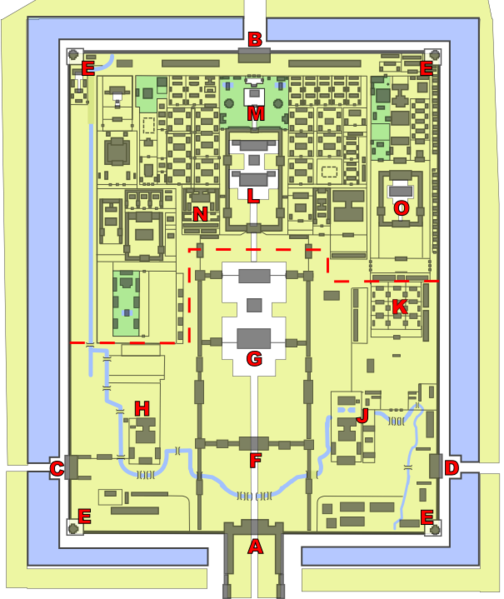
The construction of this complex required four years and involved the use of logs from the rare Phoebe Zhennan trees that were transported over four years via the river. The builders also used marble that was quarried from nearby hills, which could only be transported by sled when the ground was frozen. Special bricks, which resembled gold blocks, were made for the floor. Over time, construction used almost one million people (most conscripted) and about 100,000 artisans and craftsmen. The walled Forbidden City was enclosed within the walled Imperial City and surrounded by the Inner City. The Forbidden City was designed on a north-south axis with the southern exit leading to Tiananmen Square, today's center of Beijing. The city was divided into two parts: the outer courtyard, used during ceremonies, and the inner court area, which held the residential and governmental buildings. The design was based on traditional practices; orientation to the cardinal directions, the residences in the center of the complex, and axial walkways. The Forbidden City wall was 7.9 meters high and made of rammed earth covered with bricks and mortar. Each side of the wall had a gate; the Meridian Gate (8.4.4) was located on the southern end and had projecting wings forming a large central entrance and square. The stone path led from the gate through the city, starting the Imperial Way, the walkway for the emperor. Gate of the Divine Might (Prowess) (8.4.5) was the opening for the northern side of the wall. All of the gates were decorated with doors embedded with golden nails.
In 1420, in an effort to consolidate his control over the throne, the emperor of the Ming Dynasty moved China's capital to a site in the North, now known as Bejing. There, he built a vast complex of palaces and administrative buildings now covering 178 acres. Because access was restricted to the imperial family and to those who had business with them, it came to be known as the Forbidden City.
_2015_December_(morning).jpg?revision=1&size=bestfit&width=902&height=602) Figure \(\PageIndex{4}\): Meridian Gate, (Morio, CC BY-SA 4.0)
Figure \(\PageIndex{4}\): Meridian Gate, (Morio, CC BY-SA 4.0) The city is adorned with intricately designed towers at its four corners, each boasting a unique roof and ridges. These towers were visible to those living outside the walls, providing a stunning sight to behold. Unfortunately, the Imperial Garden lacks trees for individuals to take leisurely walks and meditate while making their way towards the gate. Towers (8.4.6) are located at all four corners, each made with intricate roofs and ridges (8.4.7). The towers were the parts of the city seen by the ordinary people who inhabited the areas outside the walls. No trees were planted outside the Imperial Garden, allowing people to take long walks toward a gate with time for meditation.

_-_China-6164.jpg?revision=1)
As you step through the Meridian Gate, you'll find yourself in a sprawling courtyard with a serene stream to cross before reaching the Gate of Supreme Harmony. Beyond that lies the heart of the complex, where the most important buildings can be found. Perhaps the most significant of these is the Hall of Supreme Harmony (8.4.8), situated in the center of the area. Towering thirty meters above the square, it represents the very essence of power and is used for everything from imperial decrees to weddings and ceremonies. Its double-eave hipped roof is a symbol of the emperor's authority, distinguishing it from other structures in the vicinity that might have a single eave or gable roof to indicate their lesser importance. Inside the Hall of Supreme Harmony (8.4.9), you'll discover a spacious throne room with six pillars, each one adorned in gold. The entire space is adorned with a dragon motif, with elongated shapes and powerful heads symbolizing the auspicious powers of the emperors. Even the sandalwood throne features ornate dragons coiled around it, adding to the grandeur and majesty permeating this unique location.
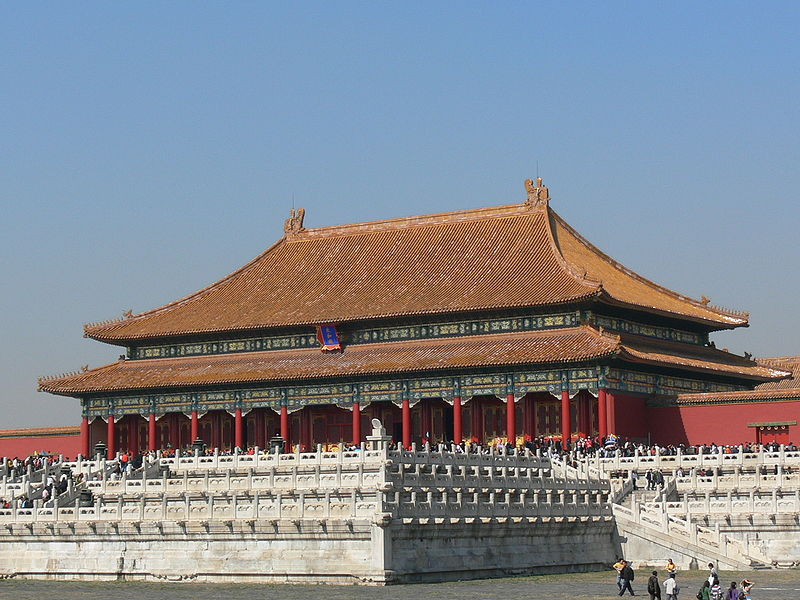
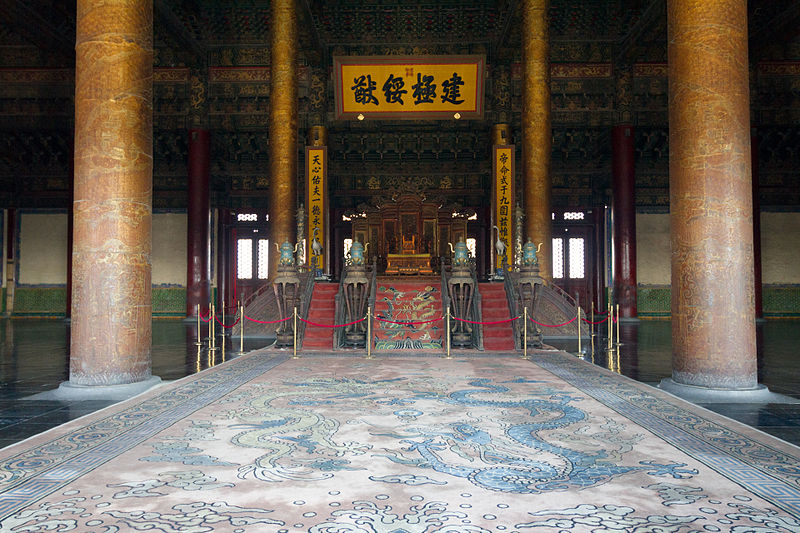
The Palace of Tranquil Longevity was constructed by an emperor who envisioned a life of opulence during his retirement years. He meticulously designed a smaller, yet lavish complex that incorporated inner and outer courts, temples, and lush gardens. The entrance to the palace was adorned with the Nine Dragons Screen, a customary wall structure meant for privacy. The wall's tiles were intricately crafted, fitting together like a puzzle (8.4.10), with each tile boasting unique designs and raised, textured parts. The wall was created through collaboration among several artists, who worked together to form an elongated shape with a commanding head (8.4.11). Using clay and an array of colors, each artist contributed to the creation of a diverse set of dragons.

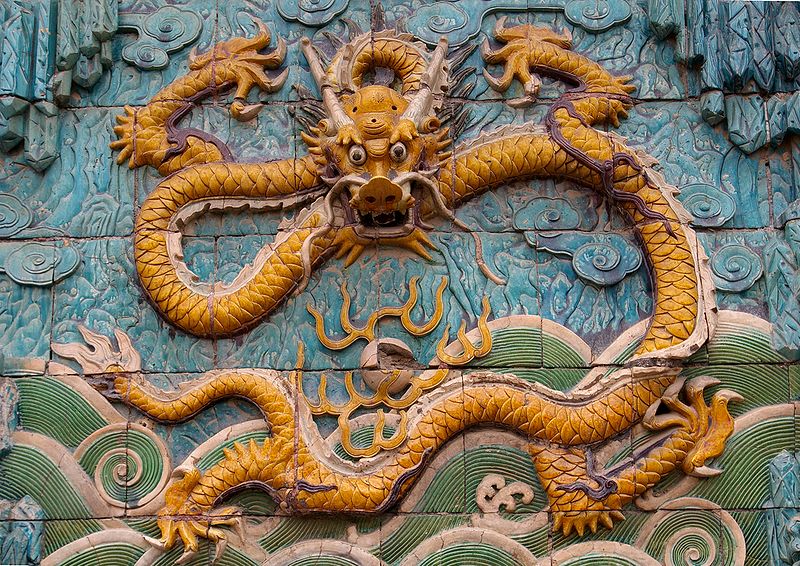
During the construction of the Forbidden City, an emphasis was placed on the importance of design, color, and symbolism, all of which were rooted in religious and philosophical concepts. Each color held a distinct meaning, with yellow being the most symbolic color of the earth and the bearer of life. As such, it was reserved for exclusive use by the emperor. The majority of the rooftops, which were the tallest structures, were adorned with glazed yellow tiles.
The auspicious color red, which the Chinese associate with power, happiness, wealth, and honor, is ubiquitous in the Forbidden City. High walls were washed with red clay from Shandon Province, which was also used to fix roofing tiles in place, and red can be seen predominantly on gates, doors, window frames, exterior timbers, and interior columns. Such was the Ming's fondness for red that all reports to the emperor had to be written on red paper, while later Qing rulers insisted that any written orders from the emperor were to be recorded in red ink. The intricately decorated interior timbers, pillars, and crossbeams (8.4.12) often set red against yellow or gold, with elaborate dragon motifs and commonly used Buddhist symbols. Gold leaf from Suzhou was often applied for finer decorations on pillars and gables.[5]
Dragons have been widely recognized as potent symbols of the emperor's immense power and authority. These majestic creatures were revered for their strength, wisdom, and ferocity and were often featured in imperial art and architecture. Similarly, the lotus flower has long been regarded as a symbol of harmony, purity, and enlightenment. Its delicate yet resilient petals were frequently used to decorate the palaces and gardens of the emperor. In addition to dragons and lotus flowers, other animals were also used to represent important virtues and values in imperial culture. The duck or heron, for example, was often associated with longevity, grace, and wisdom, while the lion was seen as a symbol of courage, protection, and strength. Stone or bronze lions were often placed at the entrance to the imperial palace, standing guard over the throne and signaling the emperor's power and authority. The opulent throne rooms in the Palace of Heavenly Purity (8.4.13) were adorned with rich red and gold decor, featuring many dragons arranged in an axial pattern to represent the emperor in all his grandeur. These dragons were often depicted in a variety of poses, such as coiling around pillars or perched atop pedestals, and were crafted from a variety of precious materials, including gold, jade, and ivory. The overall effect was one of magnificence, power, and majesty, befitting the ruler of one of the world's greatest empires.

Figure \(\PageIndex{13}\): Throne in Palace of Heavenly Purity, (Vaiz Ha, CC BY 2.0)
Headdresses have always played a vital role in the attire of royalty, particularly among women. Among these, the Fengguan, commonly referred to as the phoenix crown, was meticulously decorated with precious and rare kingfisher feathers, gold dragons, beaded birds, rubies, sapphires, and pearls. The number of embellishments on the crown depended on the wearer's rank, with the empress or crown princesses wearing the most elaborate ones. The design also determined the number of gold dragons and ornaments that could be included. The pearls, feathers, and gemstones were sculpted into symbolic ornaments like flowers or leaves. Empress Xiaochun (8.4.14) wore a crown with multiple dragons and beaded blades hanging down to indicate her high rank. Another stunning turquoise crown (8.4.15) was similar to the one in the empress's painting, with oversized golden dragons and pearl blades on the sides.
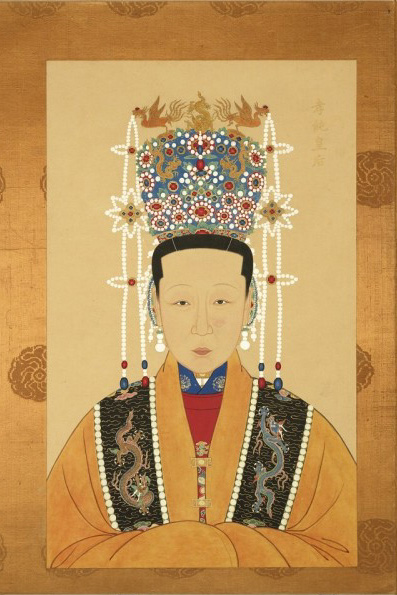
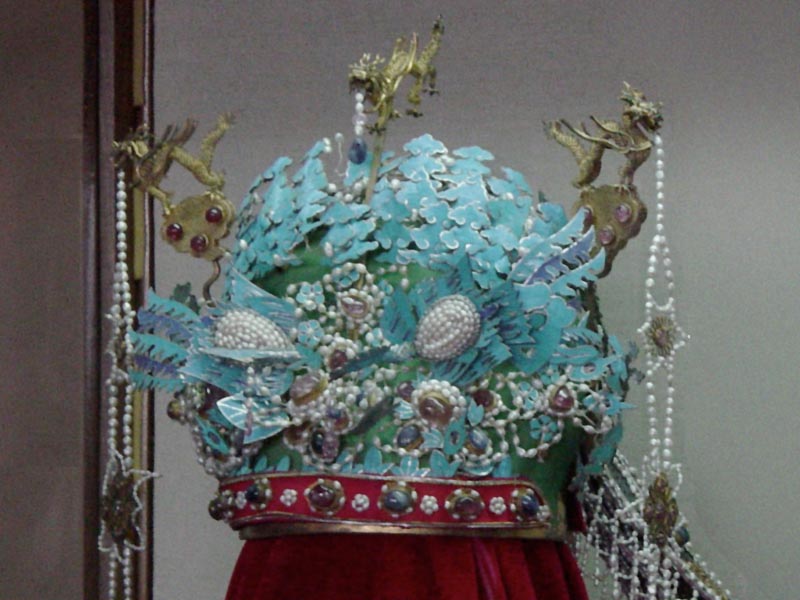
Figure \(\PageIndex{15}\): Queen's headdress (Blue tian-tsui leaves and birds, gold dragons, pearls, polished semi-precious stones) (CC BY-SA 1.0)
The Four Masters of the Ming Dynasty
During the prosperous era of the Ming Dynasty, artistic pursuits flourished in the region, particularly in the realm of painting. The artists of this era were known for their use of a diverse palette, which included seal brown, a color resembling the fur of seals. This led to the emergence of new schools, producing contemporary master painters. Shen Zhou, Wen Zhengming, Tang Yin, and Qiu Ying were among the era's most prominent painters, and they were considered masters of their craft. They all attended and taught at the Wu School, a hub for professional artists to gather, paint, and sell their paintings. The artists were adept at the "Three Perfections" of painting, calligraphy, and poetry. Qiu Ying followed the literati style of court artists Shen Zhou and Wen Zhengming, which emphasized personal intelligence, scholarship, and expression.
Wenrenhua, (文人畫), or literati painting, is a form of Chinese art that prioritizes personal expression above surface aesthetics or realistic representation. This style of painting reflects the ideals of the scholar-painter, who values erudition and creativity. Wenrenhua is a testament to the individuality of the artist, as it allows for a unique and subjective interpretation of the subject matter. This art form has been revered for centuries and continues to inspire contemporary artists seeking to express their personal vision. Rather than striving for realism in their depictions of nature, they conveyed their thoughts, ideas, and feelings through their paintings. Tang Yin, on the other hand, blended the styles of all three painters. All four painters were masters of their craft, and their paintings reflected their exceptional skills and creativity.
How this Chinese scroll confronts us with our own mortality and how to read a scroll from right to left.
Shen Zhou
Shen Zhou (1427 – 1509) was a highly regarded painter, poet, and calligrapher who came from a well-to-do family. He was considered a top-tier artist of his era and established the Wu School. Here, he introduced fresh concepts that were based on historical traditions and a more personal style which incorporated trees, rocks, and calligraphy norms. Shen Zhou was particularly renowned for his landscape, flower, and bird paintings. In Poetic Feeling of Fallen Flowers (8.4.16), the focal point is a small image of a man who appears overwhelmed by nature's grandeur, towering mountains, a vast river, and a path winding through the trees and hills. The trees and shrubs are painted with bold brushstrokes using ink and color on paper, while the background is painted with precision. For his painting Reading in Autumn Scenery (8.4.17), Shen Zhou used bold brushstrokes throughout the piece, featuring only a small pensive man in the image, and using autumn colors to signify the harvest sky. He frequently incorporated calligraphy to balance the image and impart significance to his ideas.
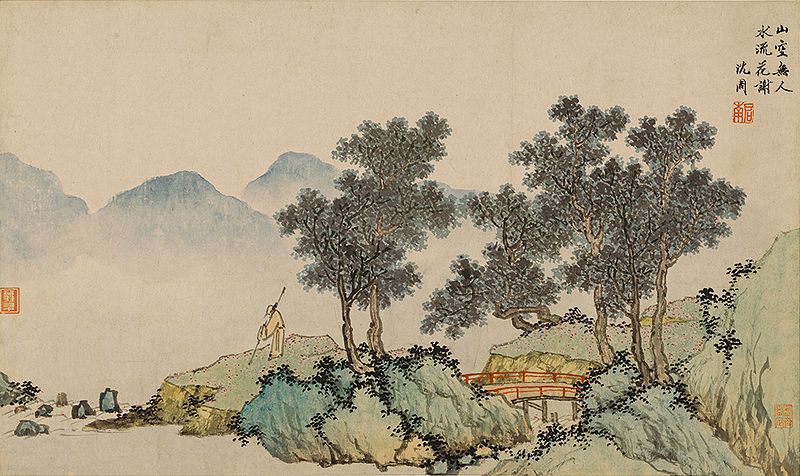
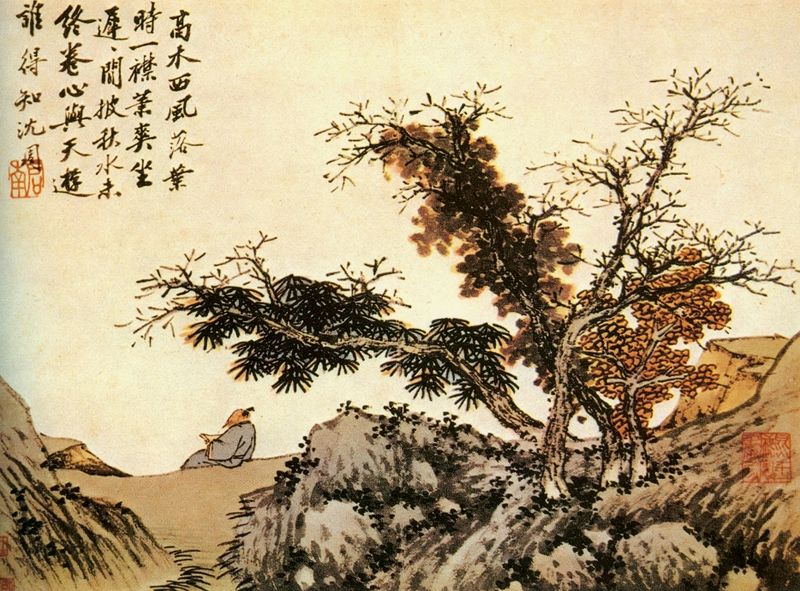
Shen Zhou, A Ming Dynasty literati, paints the panoramic hills surrounding the city of Shuzou.
Additional text/introduction.
Wen Zhengming
Wen Zhengming (1470 – 1559), a prominent Chinese artist, initially pursued a career in the government by taking civil examinations. However, he failed nine times and later shifted his focus to painting, calligraphy, and poetry. Under the guidance of Shen Zhou, he studied the works of ancient painters and developed his unique style that seamlessly integrated ink and color with varying light and dark tones. Notably, Wen favored washes of blue and green in his paintings. Among his most distinguished works is the Huishan Tea Party Map (8.4.18), which exemplifies his exceptional use of multiple tones of blue and green. The background is beautifully detailed, ranging from heavy to delicate brushstrokes.
Wen Zhengming's album of small landscapes (8.4.19), painted with ink on paper, also showcased his calligraphic expertise. He masterfully used bold strokes to depict trees and mountain tops, and delicate lines to represent buildings. Each painted image was paired with a poem (8.4.20), highlighting his artistry. His style was highly influential, adopted by many, including his sons, and he was celebrated as a leader of the Wu School alongside Shen Zhou.
In calligraphy, Wen Zhengming studied a wide range of artworks from the past. An exceptionally diligent student, he himself said that practicing calligraphy was one of his daily activities upon waking up every morning, never tiring of it throughout his life. Wen came to excel at the major calligraphic types, with small regular and running scripts most reflecting his personal style. His small regular script is sharp and orderly, and even at the age of ninety he could still do tiny "gnat's-head" writing. Wen's running script is also elegant yet vigorous, with most of such surviving works tending towards semi-cursiveness.[6]

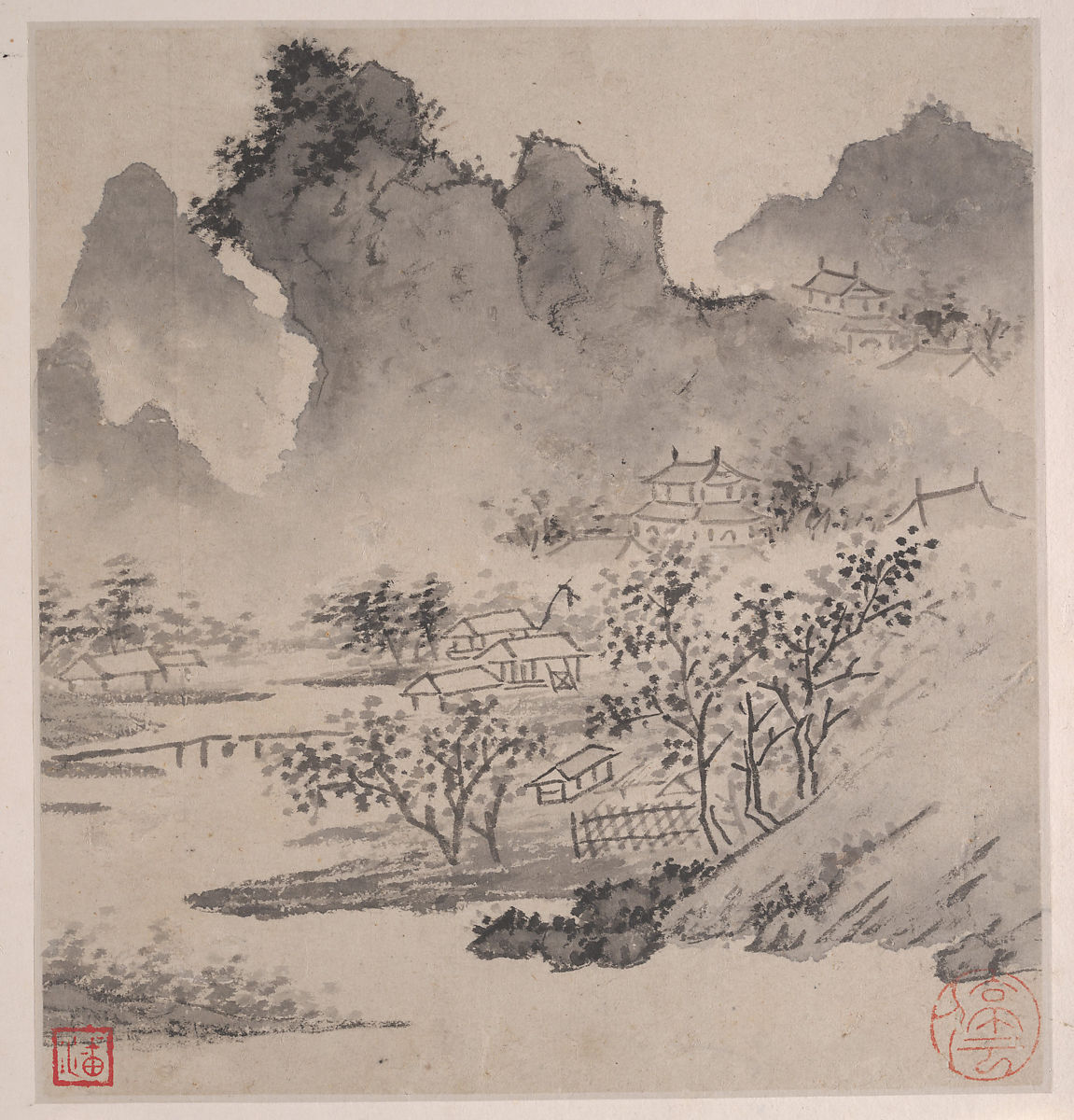
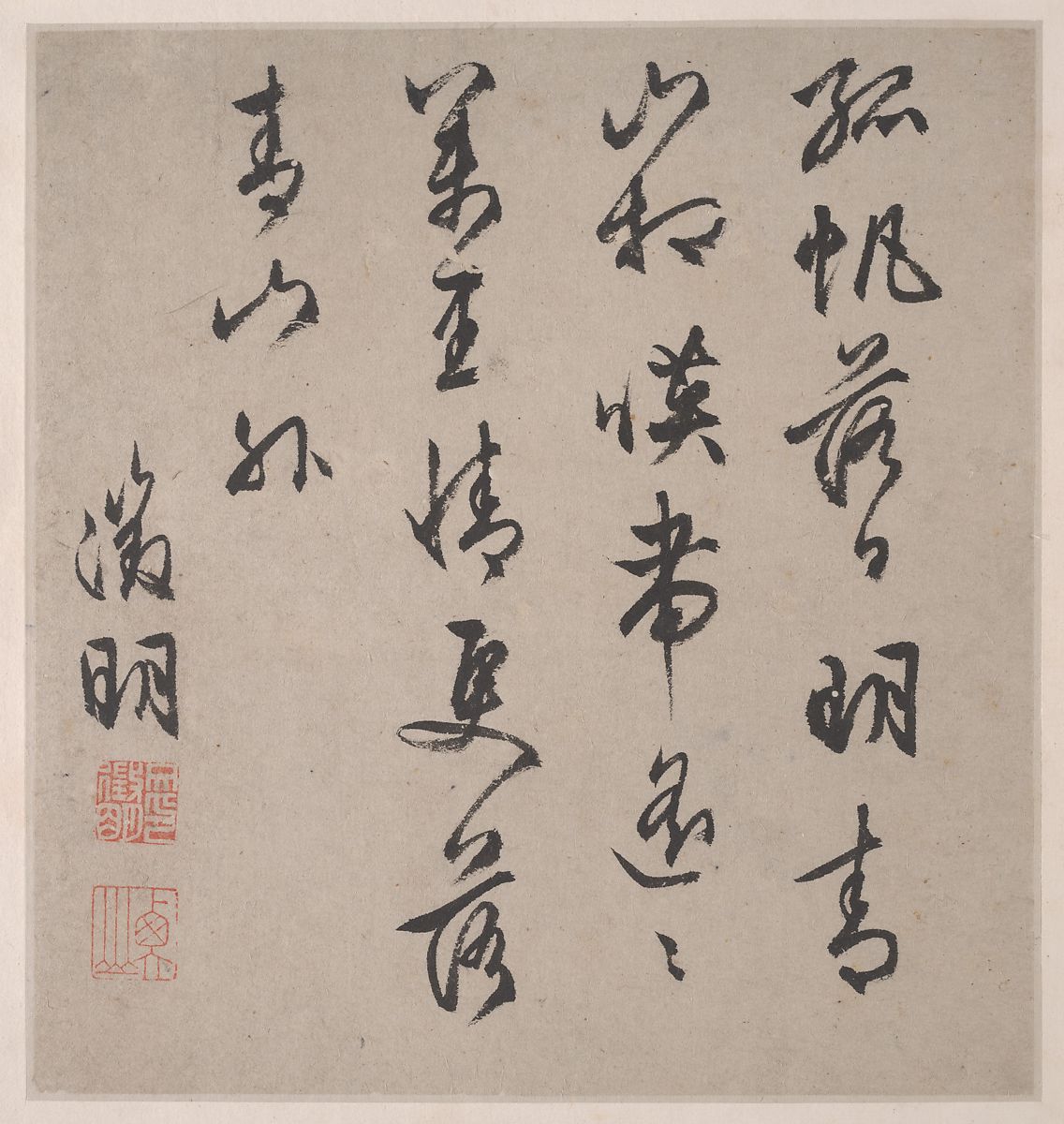
Qui Ying
Qui Ying (1494 – 1552) was a renowned painter who began his career at a young age and excelled in replicating the works of old masters. As he matured, he shifted his focus to painting figures and flowers, often against the backdrop of landscapes. His exceptional ability to create figures with delicate lines drawn in ink earned him great fame. Qiu Ying's painting Pavilions in the Mountains of the Immortals (8.4.21) depicts the beauty of nature and the concept of eternity. The painting transports you to the edge of a lush mountain range, where mist drifts around ancient pine trees like fine silk. In the foreground, elegant pavilions emerge gracefully from the rocky terrain, with curved roofs that imitate the contours of the landscape. The wooden pillars of each pavilion are adorned with intricate carvings that depict stories from bygone eras. The warm, golden hues of the sunset cast a gentle glow over the scene, creating long shadows that dance across the moss-covered stones. Ying captures the physicality of the pavilions and their spiritual essence. The pavilions embody enlightenment and transcendence, inviting the viewer to ponder the mysteries of existence amidst the tranquil embrace of nature. Through Qiu Ying's deft brushstrokes, the pavilions metamorphose into portals of a world where time slows to a languid trickle, and the lines between the worldly and the divine become blurred.
Conversely, "Spring Morning in the Han Palace" (8.4.22) is a lengthy scroll that captures numerous scenes of life and activities in the ancient palace. Qui Ying's mastery of brushwork and ability to create fine, detailed lines is evident in every aspect of the painting, from the intricate flooring to the minutiae of each figure. The hairstyles and clothing of people in the scroll are from the Han Dynasty (206 BC-AD 220), but the Ming style is evident in the palace and its furnishings. This scroll is a conceptualization of various daily activities in the palace of the Han Dynasty in the early spring, such as enjoying the zither, calligraphy, painting, playing chess as well, and appreciating antiquities and flowers. The present segment of the scroll delineates an artist seated, engrossed in painting the Emperor, surrounded by a large gathering of onlookers. The figures are dressed in bright colors and they are depicted making various gestures and adopting an assortment of postures. They appear to be busy, but a sense of leisure permeates the work. Trees and rocks decorate and punctuate the garden scenery of the lavish palace architecture.
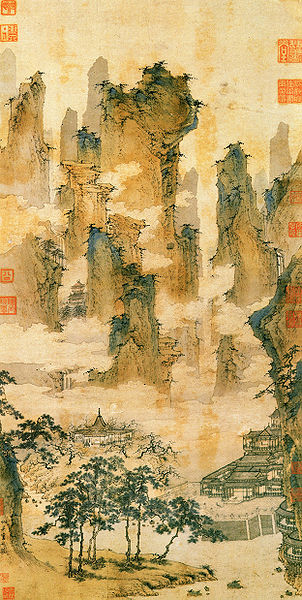
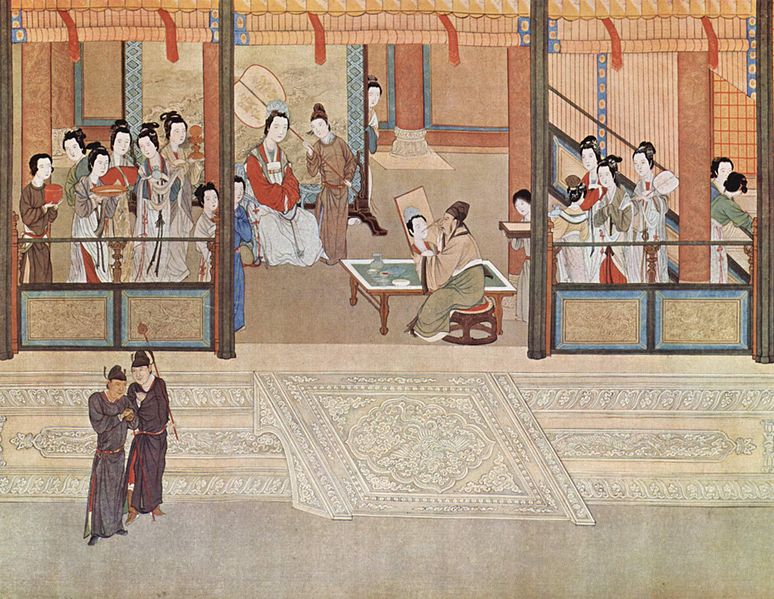 Figure \(\PageIndex{22}\): Spring Morning in the Han Dynasty (Ming Dynasty, ink and colors on silk, 30.6 x 574.1 cm) Public Domain
Figure \(\PageIndex{22}\): Spring Morning in the Han Dynasty (Ming Dynasty, ink and colors on silk, 30.6 x 574.1 cm) Public DomainTang Yin
Tang Yin (1470 – 1524) was one of the most famous of the Four Masters painters who, like the others, was accomplished as a painter, poet, and calligrapher. Early in his life, he pursued a job in the civil service where he was accused of bribing an examiner and deprived of any further service in the government, freeing him to pursue an art career. Many of his paintings focused on the activities and beauty of women and the interaction of people. Tao Gu Presenting a Lyric (8.4.22) is an early Song Dynasty story:
In the early Song (960-1279), Tao Gu (陶穀, 903-970) served an envoy to the small Five Dynasties kingdom of the Southern Tang. Tao was condescending in the face of the Southern Tang ruler Li Houzhu. The Southern Tang officials, angered by his rudeness, came up with a plot; they sent the court courtesan Qin Ruolan (秦蒻蘭) in the guise of the Station Officer’s daughter to seduce Tao. Alone in her company and unsuspecting of her true identity, Tao Gu was overcome by her beauty and forgot his official position, indiscreetly writing a poem for her. The next day, the Southern Tang ruler gave a banquet for Tao Gu. At the banquet, Tao again assumed an air of unbending dignity and unapproachability. The ruler then summoned Qin Ruolan to perform a song, which was the poem that Tao had written for her the day before. Tao Gu was thereupon greatly humiliated and he lost his composure. The painting here illustrates this story.[7]
Tao Gu Presenting a Lyric (8.4.23) captures Tao Gu seated on a daybed, illuminated by a flickering candle, with writing materials at the ready. Qin Ruolan, depicted with elaborate hair, plays the pipa in a lifelike manner just before Tao Gu begins to write his poem. Every element in the painting, from the tree and stone to the bamboo and potted flowers, is meticulously rendered to create an intimate setting. The elegant coloring and reserved yet lifelike scene make for a captivating work of art. Tang Yin's poem, located in the upper right, reveals his identification with the figure of Tao Gu.
Court Ladies in the Shu Palace (8.4.24) is a timeless masterpiece of Chinese painting that portrays four elegantly dressed ladies, each adorned with intricate headdresses and silk gowns. It is undoubtedly the result of Tang Yin's masterful brushwork, which brings out every detail of the painting in a subtle palette of colors. The artist's use of a few touches of red in the painting serves to accentuate the composition's delicate features. The central blue gown of the painting is the focal point of the artwork, giving it a sense of spatial depth that is masterfully executed.

Ming Porcelain
During the Ming Dynasty, porcelain production was consolidated in Jingdezhen, manufacturing imperial goods for the court and export. The fine white clay in the region produced a translucent quality, able to be fired at very high temperatures and produce exceptionally thin, smooth pottery. It became so important and exquisitely fashioned; the emperor had his line complete with the royal mark. The royal kilns produced the well-known Xuande style, usually in the blue and white porcelain favored by the emperor.
The Chenghua variety featured contending colors over the blue and white and overglaze outlined and filled decorations of bright reds, pine greens, or sunburst yellows. Wanli porcelain was ornately patterned and painted with five colors: red, black, yellow, green, and purple. Dehua ware became known as 'Blanc de Chine' or white china and had such a pure white color it was frequently used to make Buddhist or religious statues. Many large production kilns were constructed to satisfy the perfected porcelain, a significant export of Islamic and European trade routes. The large porcelain jar (8.4.25) made in Jiajing period has a lid painted in a pond with carp and aquatic plants with a nob on top to lift it off. The underglaze was painted with repeated designs of brown carp, water weeds and lotus flowers in blues and greens.
The ceramic material was made from kaolin clay, porcelain stone, or a mixture of both, which produced the fine white ceramic. It was usually fired by oxidizing the conditions during firing when the amount of oxygen was controlled. Improved clay combinations allowed them to make thinner vessels in a wide range of shapes and new glazes gave the ceramics a whiter, shinier look. The requirements from the Islamic world influenced the designs of the porcelain, and they imported cobalt blue from Iran, the typical color used on many vessels. The perfection and beauty of the Ming porcelains were in great demand, and in 1433, the imperial kilns had an order for 443,500 pieces of porcelain with the unique dragon and phoenix design.[8]
.jpg?revision=1&size=bestfit&width=709&height=761)
Figure \(\PageIndex{25}\): Wine Jar with carp among water weeds and lotus, Public Domain
This porcelain vase, also referred to as the Jar with the Eight Immortals, (8.4.26) is a magnificent work of art with a captivating double gourd shape. The central area of the vase showcases intricate flowers, created with an underglaze of blue scrolled lotus leaves and flowers. The repetitive design and shape of the vessel bear a resemblance to Islamic patterns, leading to speculation that it may have been crafted for export to one of the Islamic nations. The Jar with the Eight Immortals is marked with the emperor's reign and was crafted using the "wucai" technique, which involves layering painted underglaze blue and overglaze enamels. [9]
_with_the_Eight_Immortals_(Baxian)_LACMA_53.41.6a.jpg?revision=1&size=bestfit&width=669&height=682) Figure \(\PageIndex{26}\): Jar with the Eight Immortals, Public Domain
Figure \(\PageIndex{26}\): Jar with the Eight Immortals, Public DomainThe Basin with the Lotus Pond (8.4.27) is a porcelain bowl that has a dark blue color with a raised slip design of light blue and yellow flowers. This is different from the usual design. These types of ceramics are known as fahua, which means "designs with borders." They have a similar look to cloisonné enamel. To make the design, white clay paste is used to create the outlines of motifs, which are then filled with brightly colored enamels. These ceramics were produced in both the north (Shanxi) and the south (Jingdezhen) of China. Fahua ware gained popularity in the late fifteenth to the sixteenth century, which is slightly later than cloisonné. This elegant work was designed to be a small fishbowl or container for paper scrolls on a scholar's desk.
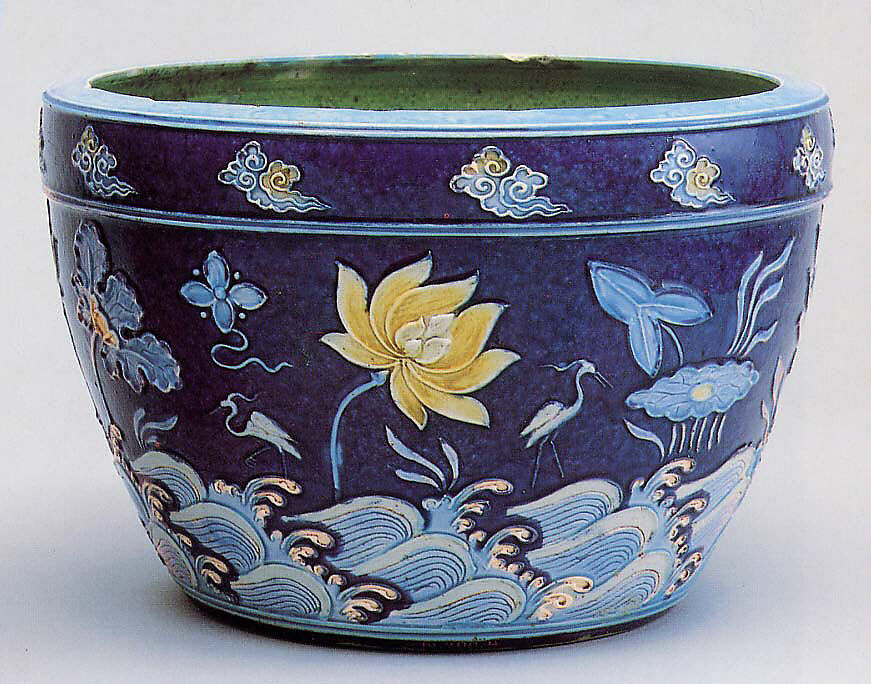
While white and blue were the most commonly used colors, porcelain of various hues was produced for both domestic and export purposes. The striking bright orange bowl (8.4.28) is adorned with an incised green dragon and secondary complementary colors. The dragon design in this unusual color combination is typical of the late fifteenth century. On the exterior, two five-clawed dragons can be seen chasing flaming pearls amidst clouds, slip-trailed onto the surface. A ring of eleven lotus lappets encircles the cup just above the foot, while a classic scroll bounded by parallel lines adorns the base of the foot. While the green enamel that highlights the high-relief designs has a uniform tonality, the yellow enamel background has a mottled appearance.
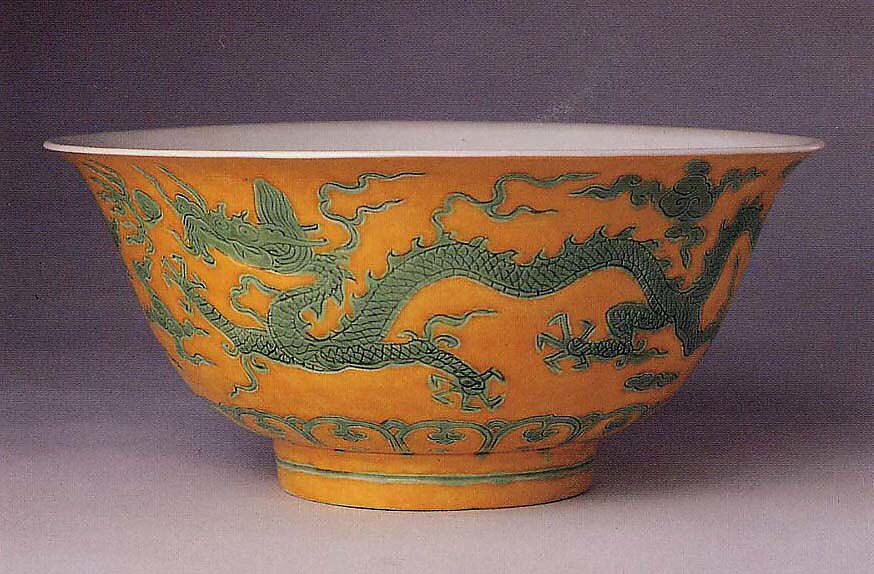
The porcelain ewer (8.4.29) is a unique pear shape; slender handle and spout that make it stand out, but what truly sets it apart is the intricate enamel and gilding. The base color, a vibrant shade of red, is beautifully complemented by accents of gold and turquoise. It's a testament to the interplay between different art forms during the sixteenth century. The ewer's design is based on a metal wine ewer, while the golden birds and flowers on the bright red enamel draw inspiration from luxurious lacquerware. Meanwhile, the turquoise-blue enamel adds a fresh pop of color that calls to mind the intricate designs of cloisonné.
 Figure \(\PageIndex{29}\): Porcelain ewer (Ming dynasty, mid-16th century, 29.2 x 14 x 12.7 cm) Public Domain
Figure \(\PageIndex{29}\): Porcelain ewer (Ming dynasty, mid-16th century, 29.2 x 14 x 12.7 cm) Public DomainIn later centuries, the art of the Ming dynasty was considered flamboyant and affected by too many ideas from other places. However, further evaluation led many to believe Ming art had "boldness and originality, perfection of craftsmanship and whimsicality, above all with a strength and splendor comparable only to the strength and splendor of the baroque art of Versailles."[10]
The use of copper in ceramic glazes goes back to the Tang Dynasty, however it was almost lost after the late Ming Dynasty. Copper red glaze is a famous yet little-known colored glaze used in the Ming Dynasty. The bright red glaze was achieved by using copper as the main coloring agent and developed using a mix of different chemical compositions and experimenting with firing temperatures.[11] The Ming Dynasty Emperors highly respected the deep red color (8.4.30) as it was considered one of the most distinguished colors in the world and was the most difficult to create. This exquisite dish is crafted from delicate porcelain and boasts a stunning monochrome copper-red glaze both inside and out. Its shallow shape features an everted rim and a tapering foot ring, while the unique glaze is adorned with tiny pinpricks that give the appearance of human pores. The center of the dish is sunken in the firing process, adding to its one-of-a-kind charm. As the glaze has bled away from the rim, the white porcelain body is revealed, creating a beautiful contrast. A transparent glaze with a blue tint covers the base, adding an extra touch of sophistication. The red glaze is created by skillfully adding a small amount of copper oxide to the same clear glaze used for Jingdezhen's iconic white and blue-and-white wares.

A conversation with Jan Stuart, Melvin R. Seiden Curator of Chinese Art, Freer Gallery of Art and Arthur M. Sackler Gallery and Steven Zucker in front of Dish with copper-red glaze, Ming dynasty, porcelain with copper-red glaze; on the base, a six-character cobalt-oxide (blue reign mark in a double circle under colorless glaze, c. 1426-35, 4.6 x 22 cm (Freer Gallery of Art, Smithsonian Institution, Washington D.C)
[2] O’Riley, M. K., (2002). Art Beyond the West, Prentice Hall, p. 133.
[3] Ho, Robert. (2008). In the Forbidden City. China Institute in America. (Introduction).
[4] Imperial Palaces of the Ming and Qing Dynasties in Beijing and Shenyang
[5] Gao, J., Education About Asia, Symbolism in the Forbidden City, 21(3), Winter 2016.
[6] China Online Museum, Wen Zhengming
[8] Morris, R. C., (16 October 2014). New York Times, Ming: The Dynasty Behind the Vases.
[10] Grigaut, P. (1952). Art of The Ming Dynasty. Archaeology,5(1), 11-13.
[11] Cui Jia, Gen Li, Ming Guan, Jin Zhao, Yi Zheng, Guangyao Wang, Xiangjun Wei, Yong Lei. (2021). A short but glorious porcelain glaze of Early Ming Dynasty: New finding of raw material and colorants in the copper red glaze. Journal of the European Ceramic Society. (41)(6) (Pg. 3809-3815).


